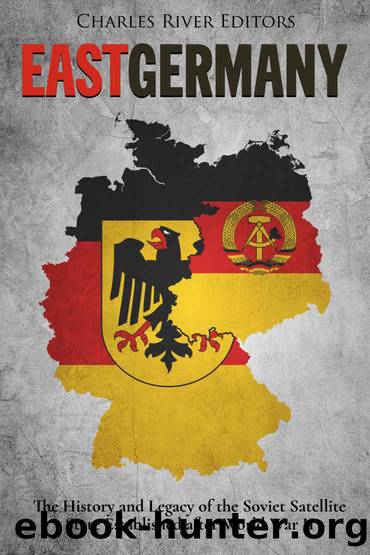East Germany: The History and Legacy of the Soviet Satellite State Established after World War II by Charles River Editors

Author:Charles River Editors
Language: eng
Format: epub
Publisher: Charles River Editors
Published: 2017-11-27T00:00:00+00:00
Struggling to Secure Legitimacy
Securing the DDRâs borders and stemming the loss of labor and skills gave the SED increased confidence to try out new domestic policies. Whereas First Secretary Ulbricht had been resistant to liberalization in the 1950s, he now realized that the lack of material progress was undermining socialist rule, and by the early 1960s, a debate took was taking place within the communist world, including the Soviet Union, over how to reform their moribund economies.[94] The issue was particularly acute in the DDR, where progress could be directly compared with the Wirtschaftswunder in West Germany. The relative economic advancement of the two states was an indictment of centrally-planned socialism and a great advertisement for liberal capitalism. The BRD had been transformed from rubble into an export-driven, prosperous society within a short period of time, while the DDR was particularly lacking in consumer goods, with shops containing a single variety of most items and often experiencing shortages. "Luxury" goods, such as the DDR-produced Trabant car (known as "Trabi" to Germans), required "consumers" to sit on a waiting list, depending on their proximity to Berlin and their SED party contacts, which could stretch out over a period of many months or even years.
This realization may have served, partly, as justification for the Neues Ãkonomisches System (New Economic System) introduced by Ulbricht in 1963. The NÃS contained a number of mildly liberalizing measures intended to improve growth and material progress, allowing for some degree of entrepreneurship and incentivizing, as well as a more liberal approach to music and literature.[95] It is difficult to assess how successful the program actually was due to its relatively short implementation period. It is possible that it could have transformed the economic fortunes of the DDR and its citizens, but the policy was gradually abandoned at the end of the 1960s. This was, in part, because of events in Czechoslovakia, where the Prague Spring â a social and economic liberalization dubbed "socialism with a human face" - was brutally rubbed out by an invasion of Warsaw Pact forces in August 1968.[96] A similar pattern of protest and crackdown occurred in Poland in 1970. In addition, hardliners in the ruling SED in East Germany had not been overly supportive of the policy in the first place,[97] and it was clear to others in the communist bloc that Moscow would not tolerate significant economic liberalization.
As well as material progress, the SED regime of the 1960s faced a recurring problem over how to achieve recognition from the rest of the world. Since its foundation in 1949, most countries had refused to recognize the DDR, shutting it out of international institutions like the United Nations (UN). This issue was compounded by the official policy of the BRD. Walter Hallstein, at the West German Foreign Ministry, had stated in 1955 that any country maintaining diplomatic relations with the DDR (with the exception of the Soviet Union itself) would be considered persona non grata in Bonn. What came to be known as
Download
This site does not store any files on its server. We only index and link to content provided by other sites. Please contact the content providers to delete copyright contents if any and email us, we'll remove relevant links or contents immediately.
| Africa | Americas |
| Arctic & Antarctica | Asia |
| Australia & Oceania | Europe |
| Middle East | Russia |
| United States | World |
| Ancient Civilizations | Military |
| Historical Study & Educational Resources |
Magic and Divination in Early Islam by Emilie Savage-Smith;(1500)
Ambition and Desire: The Dangerous Life of Josephine Bonaparte by Kate Williams(1346)
Bohemians, Bootleggers, Flappers, and Swells: The Best of Early Vanity Fair by Bohemians Bootleggers Flappers & Swells- The Best of Early Vanity Fair (epub)(1344)
Papillon by Henry Charrière(1310)
Twelve Caesars by Mary Beard(1258)
Operation Vengeance: The Astonishing Aerial Ambush That Changed World War II by Dan Hampton(1137)
What Really Happened: The Death of Hitler by Robert J. Hutchinson(1130)
London in the Twentieth Century by Jerry White(1114)
Time of the Magicians by Wolfram Eilenberger(1089)
The Japanese by Christopher Harding(1086)
Twilight of the Gods by Ian W. Toll(1084)
Lenin: A Biography by Robert Service(1045)
The Devil You Know by Charles M. Blow(985)
A Social History of the Media by Peter Burke & Peter Burke(938)
Freemasons for Dummies by Hodapp Christopher;(923)
Napolean Hill Collection by Napoleon Hill(903)
Henry III by David Carpenter;(892)
The Churchill Complex by Ian Buruma(884)
The Rise and Triumph of the Modern Self by Unknown(880)
